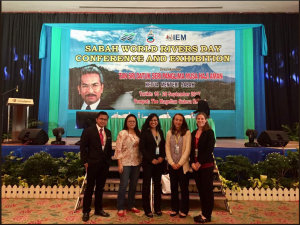
Representatives from DID, UK & Malaysian Universities and SEARRP
Scientists working together as part of the LOMBOK Project (Land-use Options for Maintaining BiOdiversity & eKosystem functions) aim to address this disparity by promoting the outcomes of their research to DID Sabah, which is the government agency responsible for formulating policy and guidelines on riparian reserves in Sabah. Additional funding from NERC, the British Council and the Malaysian Industry-Government Group for High Technology (MIGHT) via the Newton-Ungku Omar Fund, has enabled LOMBOK scientists to establish a network of biodiversity monitoring and carbon (C) dynamics plots within riparian reserves which tests the effectiveness of riparian reserves – particularly by investigating the effects of the quality and width of riparian reserves on water quality, aquatic and terrestrial biodiversity and carbon fluxes.
This innovative collaboration between DID and the LOMBOK Project was facilitated by Agnes Agama, SEARRP’s Assistant Director of Policy. Agnes initiated the partnership at the 2016 Heart of Borneo (HoB) International Conference, hosted by the Sabah Forestry Department in Kota Kinabalu – during which SEARRP facilitated a workshop that paired scientists with policy-makers. It was at this workshop that opportunities emerged for SEARRP scientists to support DID in their efforts to strengthen riparian policy and guidelines for Sabah.
Following the workshop, scientists in the LOMBOK group, Eleanor Slade, Sarah Luke, Matthew Struebig, and students from the UK and UMS conducted a rapid evidence appraisal of the peer-reviewed scientific literature concerning the potential benefits of riparian reserves in tropical agriculture. The outcomes of this review have been synthesised into a policy brief aimed at informing the review of DID’s riparian policy and guidelines by enabling policy-makers to make decisions based on current scientific knowledge. The policy brief will be co-presented by DID and the LOMBOK group at the 2017 HoB International Conference which runs from October 24-25th in Kota Kinabalu. The presentation will highlight the collaborative processes that underpin our relationship, from fledging introductions at last year’s conference to the delivery of a high-impact, science-for-policy output a year later. It is an excellent example of how scientists and policy-makers can successfully work together to ensure that cutting edge research effectively contributes to improvements in policy and best practice.
